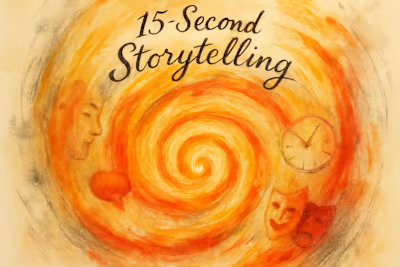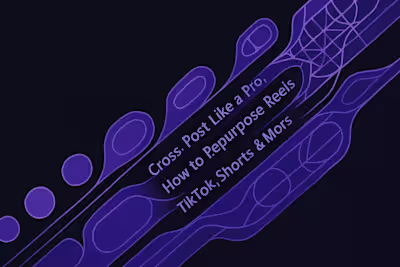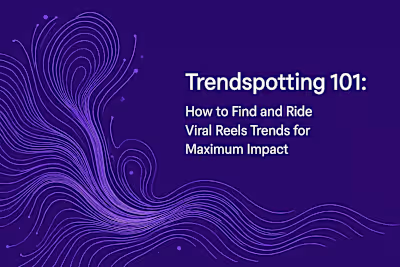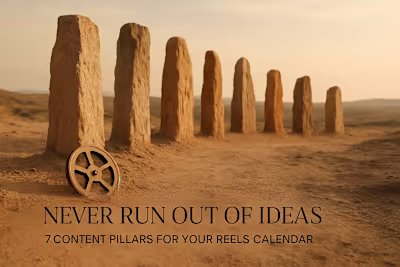Crafting the Perfect Brief: How to Get the Reel You Envision

Crafting the Perfect Brief: How to Get the Reel You Envision
Why a Detailed Brief is Non-Negotiable
Aligning Vision and Expectations
Saving Time and Budget
The Anatomy of a Perfect Reels Brief
Project Objective and Background
Target Audience
Key Message
Tone, Style, and Visual References
Deliverables and Technical Specs
Mandatory Elements and Exclusions
Common Pitfalls to Avoid When Writing Your Brief
Being Too Vague
Overloading with Information
Forgetting the Call-to-Action
References
Crafting the Perfect Brief: How to Get the Reel You Envision
Hiring a Reels videographer is an exciting step towards creating dynamic content. But before the magic happens, a crucial document lays the groundwork for success: the creative brief. This guide will walk you through creating a brief that leaves no room for confusion, ensuring the final Reel is exactly what you envisioned.
A clear brief not only sets expectations but also streamlines the entire creative process, including the crucial stage of giving notes, which is key to the feedback loop. To get started on your next project, find the perfect independent Reels videographer to bring your vision to life.
Why a Detailed Brief is Non-Negotiable
Think of your creative brief as the GPS for your video project. Without it, you and your videographer might end up in completely different destinations. A strong brief acts as the strategic roadmap that keeps everyone on the same path.
When you take the time to create a thorough brief, you're essentially having all the important conversations upfront. This alignment between you and your videographer on goals, scope, and creative direction saves everyone headaches later. No more endless revision rounds or that sinking feeling when you see a final product that looks nothing like what you imagined.
Aligning Vision and Expectations
Here's a scenario that happens all too often: You hire a talented videographer who creates something visually stunning. The transitions are smooth, the colors pop, and the editing is flawless. There's just one problem – it completely misses your strategic goals.
Maybe you wanted to showcase your product's ease of use, but the video focuses on its sleek design. Or perhaps you needed something that speaks to busy parents, but the content feels more suited to tech-savvy millennials. Without a brief, even the most skilled creator is essentially working blindfolded.
Your brief translates abstract ideas into concrete instructions. Instead of hoping your videographer can read your mind, you're giving them a clear blueprint to follow. It's the difference between saying "make it cool" and explaining exactly what "cool" means for your brand and audience.
Saving Time and Budget
Let's talk about the real cost of poor communication. Every round of revisions takes time. Every misunderstood direction leads to rework. And in the world of content creation, time literally equals money.
A well-defined brief helps your videographer work efficiently from day one. They know exactly what shots to capture, which effects to use, and how to structure the narrative. This clarity upfront means fewer surprises during the review process and significantly reduces those costly back-and-forth edits.
Consider this: spending an extra hour perfecting your brief could save you days of revision time later. That's not just good project management – it's smart business.
The Anatomy of a Perfect Reels Brief
Creating a comprehensive brief doesn't have to be complicated. Think of it as answering all the questions your videographer might have before they even ask them. A good brief covers several key areas that give your creator a complete picture of what you're after.
The best briefs strike a balance between being thorough and being accessible. You want to provide enough detail to guide the creative process without overwhelming your videographer with unnecessary information. Let's break down each essential component.
Project Objective and Background
Start with the big picture. What's driving this project? Your videographer needs to understand not just what you want, but why you want it.
Begin by clearly stating your primary goal. Are you launching a new product and need to generate buzz? Looking to educate your audience about a complex service? Trying to humanize your brand with behind-the-scenes content? Be specific about what success looks like for this Reel.
Then provide context. Give a brief overview of your company and explain how this Reel fits into your larger marketing strategy. If it's part of a campaign, share the campaign theme. If it's responding to a trend or competitor activity, mention that too. This background helps your videographer make creative decisions that align with your broader objectives.
Target Audience
Your videographer can't create content that resonates unless they know who they're creating for. Paint a clear picture of your ideal viewer.
Go beyond basic demographics. Sure, "women aged 25-34" is a start, but what really makes your audience tick? What are their interests, challenges, and aspirations? Do they scroll Reels during their morning commute or late at night when the kids are asleep? Are they looking for quick tips or deeper inspiration?
The more specific you can be, the better. Instead of "young professionals," try "ambitious marketing managers in mid-sized companies who are overwhelmed by new digital tools and looking for simple productivity hacks." This level of detail helps your videographer choose everything from music tempo to visual style.
Key Message
Here's where many briefs go wrong – they try to say everything at once. Your Reel has seconds to make an impact, so you need laser focus on one core message.
What's the single most important thing viewers should remember? If they forget everything else, what should stick? This isn't the place for your entire value proposition. Pick one compelling point and make it memorable.
Write your key message in one clear sentence. Test it by asking yourself: "If someone watched this Reel on mute in a crowded subway, would they still get this point?" If the answer is yes, you're on the right track.
Tone, Style, and Visual References
Words can only go so far when describing visual content. This section is where you really help your videographer understand the look and feel you're after.
Start with the mood. Should viewers feel energized and inspired? Calm and reassured? Curious and intrigued? Use descriptive words that paint an emotional picture. Is your brand voice playful or professional? Trendy or timeless?
Then get specific about visual style. Do you prefer quick cuts or smooth transitions? Bright, saturated colors or muted, sophisticated tones? Natural lighting or dramatic effects?
The real secret here is showing, not just telling. Include links to 2-3 Reels that capture the vibe you want. Even better, include one or two examples of what you definitely don't want. Sometimes knowing what to avoid is just as helpful as knowing what to aim for.
Deliverables and Technical Specs
This might seem like the boring part, but getting technical specifications right is crucial for a smooth project. Nothing's worse than receiving a beautiful video that's in the wrong format.
List every version you need. Will this Reel also be cut down for Stories? Do you need a square version for your feed? Should there be versions with and without text overlays? Be specific about:
Video dimensions (9:16 for Reels, 1:1 for feed posts)
Length requirements (remember, Reels can be up to 90 seconds)
Whether you need subtitles or captions
File formats and resolution requirements
Any platform-specific requirements
Don't assume your videographer knows your needs. Even experienced creators appreciate clear technical guidelines.
Mandatory Elements and Exclusions
Every brand has non-negotiables. This section ensures nothing important gets missed and nothing problematic slips in.
Start with must-haves. Does your logo need to appear? Is there specific product packaging that should be featured? Do you have brand colors that must be incorporated? List any required text, hashtags, or calls-to-action.
Equally important is what to avoid. Maybe your competitor uses a specific color you want to steer clear of. Perhaps certain words or phrases don't align with your brand voice. If you're in a regulated industry, there might be claims you can't make or disclaimers you must include.
Being explicit about these requirements upfront prevents awkward conversations and revisions later.
Common Pitfalls to Avoid When Writing Your Brief
Even with the best intentions, briefs can go wrong. Understanding common mistakes helps you create a document that actually helps rather than hinders the creative process.
Being Too Vague
"Just be creative with it" might sound like you're giving creative freedom, but it's actually a recipe for disappointment. Vague instructions lead to guesswork, and guesswork rarely aligns with your vision.
Instead of broad statements, provide specific direction. Rather than "make it fun," explain what fun looks like for your brand. Does it mean using trending audio? Including humor? Featuring bright colors and fast cuts?
Remember, creative constraints often lead to better results than complete freedom. Your videographer wants to deliver something you'll love. Give them the information they need to succeed.
Overloading with Information
On the flip side, there's such a thing as too much detail. A 10-page brief filled with marketing jargon and every thought you've ever had about your brand will overwhelm rather than inform.
Keep your brief focused and scannable. Use bullet points for quick reference. Highlight the most critical information. If you find yourself writing paragraphs about your company history, ask yourself: "Does the videographer really need this to create a great Reel?"
Save the comprehensive brand guidelines for later. Your brief should contain just enough information to get the project started on the right foot.
Forgetting the Call-to-Action
Here's something many people overlook: every great Reel guides viewers on what to do next. Without a clear call-to-action, even the most engaging content fails to drive results.
Be specific about the action you want viewers to take. Should they visit your website? Follow your page? Use a specific hashtag? Try your product? The CTA shapes how your videographer structures the content and ensures your Reel doesn't just entertain – it converts.
Include not just what the CTA should say, but how it should be presented. Should it be a text overlay? Spoken in voiceover? Shown as a final frame? These details matter for creating a smooth, effective viewer journey.
Creating the perfect brief takes effort, but it's an investment that pays off in smoother production, fewer revisions, and better final results. Your brief is the foundation of a successful collaboration with your videographer. Take the time to make it clear, comprehensive, and actionable.
Remember, your videographer wants to create something amazing for you. A great brief gives them the tools to do exactly that. With these guidelines in hand, you're ready to write a brief that turns your vision into reality – a Reel that not only looks great but achieves your business goals.
References
Like this project
Posted Jun 30, 2025
Hiring a Reels videographer? A detailed creative brief is your first step to success. Learn what to include to ensure your vision comes to life seamlessly.







